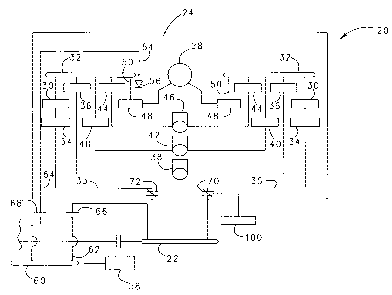Some of the information on this Web page has been provided by external sources. The Government of Canada is not responsible for the accuracy, reliability or currency of the information supplied by external sources. Users wishing to rely upon this information should consult directly with the source of the information. Content provided by external sources is not subject to official languages, privacy and accessibility requirements.
Any discrepancies in the text and image of the Claims and Abstract are due to differing posting times. Text of the Claims and Abstract are posted:
| (12) Patent: | (11) CA 2638961 |
|---|---|
| (54) English Title: | GENERATOR FOR GAS TURBINE ENGINE HAVING MAIN DC BUS ACCESSORY AC BUS |
| (54) French Title: | GENERATEUR POUR TURBINE A GAZ POURVU D'UNE BARRE OMNIBUS PRINCIPALE POUR COURANT CONTINU ET D'UNE BARRE OMNIBUS AUXILIAIRE POUR COURANT ALTERNATIF |
| Status: | Expired and beyond the Period of Reversal |
| (51) International Patent Classification (IPC): |
|
|---|---|
| (72) Inventors : |
|
| (73) Owners : |
|
| (71) Applicants : |
|
| (74) Agent: | NORTON ROSE FULBRIGHT CANADA LLP/S.E.N.C.R.L., S.R.L. |
| (74) Associate agent: | |
| (45) Issued: | 2012-03-20 |
| (22) Filed Date: | 2008-08-20 |
| (41) Open to Public Inspection: | 2009-03-21 |
| Examination requested: | 2008-08-20 |
| Availability of licence: | N/A |
| Dedicated to the Public: | N/A |
| (25) Language of filing: | English |
| Patent Cooperation Treaty (PCT): | No |
|---|
| (30) Application Priority Data: | ||||||
|---|---|---|---|---|---|---|
|
An aircraft electrical system includes a generator that supplies electrical AC power to a plurality of accessories associated with a gas turbine engine. The generator also supplies power to an aircraft DC bus in parallel to the supply to the accessory bus.
Un système électrique d'aéronef comprend un alternateur qui alimente en courant alternatif de multiples accessoires associés à une turbine à gaz. L'alternateur alimente une barre omnibus en courant continu d'aéronef en parallèle sur l'alimentation appliquée à la barre omnibus d'accessoires.
Note: Claims are shown in the official language in which they were submitted.
Note: Descriptions are shown in the official language in which they were submitted.

2024-08-01:As part of the Next Generation Patents (NGP) transition, the Canadian Patents Database (CPD) now contains a more detailed Event History, which replicates the Event Log of our new back-office solution.
Please note that "Inactive:" events refers to events no longer in use in our new back-office solution.
For a clearer understanding of the status of the application/patent presented on this page, the site Disclaimer , as well as the definitions for Patent , Event History , Maintenance Fee and Payment History should be consulted.
| Description | Date |
|---|---|
| Time Limit for Reversal Expired | 2015-08-20 |
| Letter Sent | 2014-08-20 |
| Grant by Issuance | 2012-03-20 |
| Inactive: Cover page published | 2012-03-19 |
| Inactive: Final fee received | 2012-01-06 |
| Pre-grant | 2012-01-06 |
| Notice of Allowance is Issued | 2011-08-08 |
| Letter Sent | 2011-08-08 |
| Notice of Allowance is Issued | 2011-08-08 |
| Inactive: Approved for allowance (AFA) | 2011-08-04 |
| Amendment Received - Voluntary Amendment | 2011-06-28 |
| Inactive: S.30(2) Rules - Examiner requisition | 2011-01-20 |
| Amendment Received - Voluntary Amendment | 2010-10-25 |
| Inactive: S.30(2) Rules - Examiner requisition | 2010-05-04 |
| Inactive: Cover page published | 2009-03-25 |
| Application Published (Open to Public Inspection) | 2009-03-21 |
| Inactive: IPC assigned | 2009-03-12 |
| Inactive: First IPC assigned | 2009-03-11 |
| Inactive: IPC assigned | 2009-03-11 |
| Inactive: IPC assigned | 2009-03-11 |
| Inactive: IPC assigned | 2009-03-09 |
| Inactive: IPC removed | 2009-03-06 |
| Inactive: IPC assigned | 2009-03-06 |
| Inactive: IPC assigned | 2009-03-06 |
| Inactive: Filing certificate - RFE (English) | 2008-10-07 |
| Filing Requirements Determined Compliant | 2008-10-07 |
| Letter Sent | 2008-10-07 |
| Application Received - Regular National | 2008-10-07 |
| Request for Examination Requirements Determined Compliant | 2008-08-20 |
| All Requirements for Examination Determined Compliant | 2008-08-20 |
There is no abandonment history.
The last payment was received on 2011-07-14
Note : If the full payment has not been received on or before the date indicated, a further fee may be required which may be one of the following
Please refer to the CIPO Patent Fees web page to see all current fee amounts.
| Fee Type | Anniversary Year | Due Date | Paid Date |
|---|---|---|---|
| Request for examination - standard | 2008-08-20 | ||
| Application fee - standard | 2008-08-20 | ||
| MF (application, 2nd anniv.) - standard | 02 | 2010-08-20 | 2010-08-20 |
| MF (application, 3rd anniv.) - standard | 03 | 2011-08-22 | 2011-07-14 |
| Final fee - standard | 2012-01-06 | ||
| MF (patent, 4th anniv.) - standard | 2012-08-20 | 2012-07-16 | |
| MF (patent, 5th anniv.) - standard | 2013-08-20 | 2013-07-11 |
Note: Records showing the ownership history in alphabetical order.
| Current Owners on Record |
|---|
| PRATT & WHITNEY CANADA CORP. |
| HAMILTON SUNDSTRAND CORPORATION |
| Past Owners on Record |
|---|
| GREGORY I. ROZMAN |
| KEVIN DOOLEY |